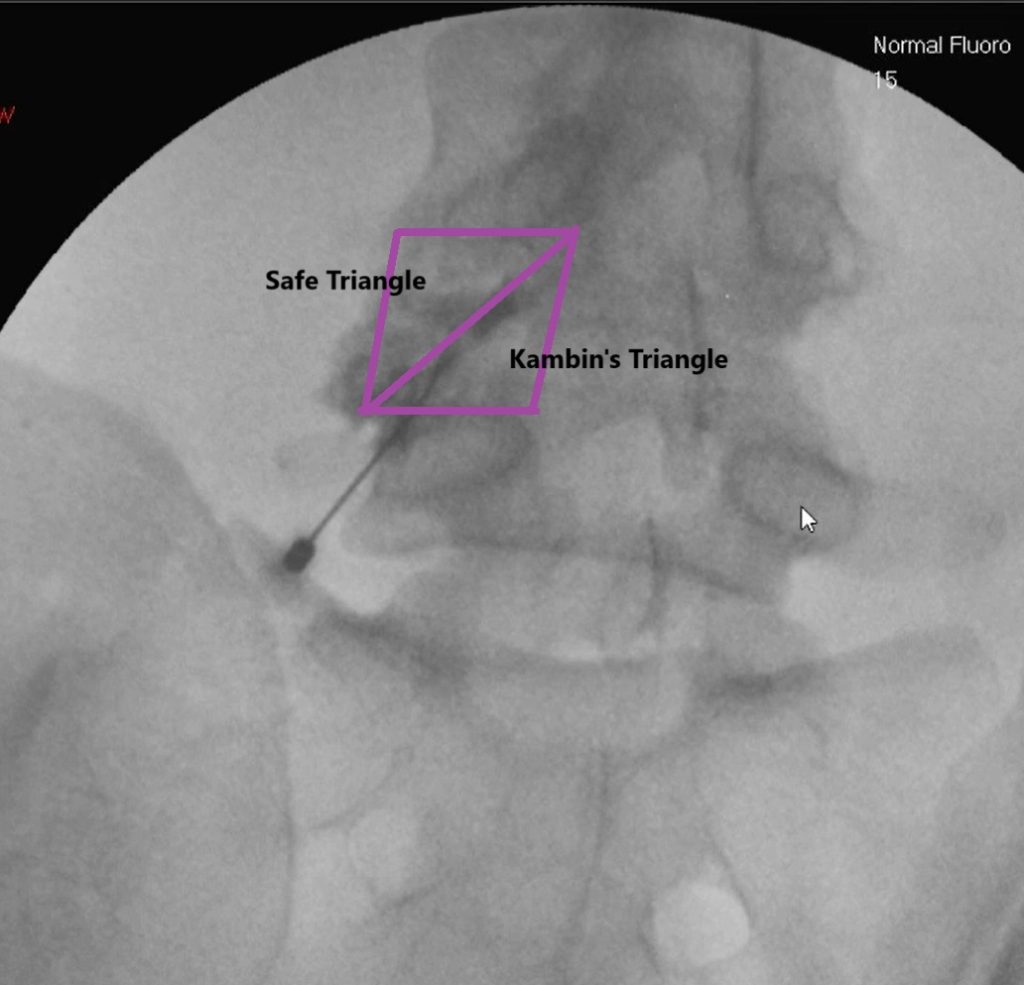Transforaminal Epidural Steroid Injection (TFESI) Using Kambin’s Triangle Approach

Transforaminal Epidural Steroid Injection (TFESI)
Introduction
Transforaminal Epidural Steroid Injection (TFESI) is a commonly performed intervention for radicular pain due to lumbar disc herniation, spinal stenosis, or nerve root inflammation. The Kambin’s Triangle approach is an alternative method to the traditional Safe Triangle approach, offering improved safety and effectiveness.
This article will cover:
✔️ Anatomy and importance of Kambin’s Triangle
✔️ Step-by-step technique for performing TFESI
✔️ Fluoroscopic guidance and confirmation with dye
✔️ Advantages of Kambin’s Triangle approach over the Safe Triangle approach
Kambin’s Triangle: Anatomical Considerations

Kambin’s Triangle is a natural corridor for accessing the epidural space through the transforaminal route without violating vital structures. It is bounded by:
🔹 Base – Superior endplate of the caudal vertebra
🔹 Hypotenuse – Spinal nerve root
🔹 Posterior border – Articular facet joint
This approach is considered safer as it avoids the dorsal root ganglion (DRG) and reduces the risk of vascular injury.
Description of the Image
The provided fluoroscopic images illustrate a Transforaminal Epidural Steroid Injection (TFESI) using Kambin’s Triangle approach in Oblique (Left) and Lateral (Right) views.
Oblique View (Left Image)
✔️ The needle is advanced into the safe corridor of Kambin’s Triangle.
✔️ The needle tip is positioned just anterior to the superior articular process, avoiding the nerve root.
✔️ A contrast dye injection is performed to confirm epidural spread and avoid vascular uptake before steroid administration.
Lateral View (Right Image)
✔️ The needle tip is seen in the epidural space, positioned at the anterior edge of the foramen.
✔️ The contrast dye outlines the nerve root, ensuring accurate medication placement.
✔️ Proper lateral positioning prevents intrathecal or vascular injection.
Step-by-Step Guide: TFESI Using Kambin’s Triangle Approach
1️⃣ Patient Positioning
✔️ The patient is placed in the prone position with a pillow under the abdomen to reduce lumbar lordosis.
✔️ The C-arm is positioned obliquely (around 20-25° tilt) to visualize the foramen.
2️⃣ Targeting the Needle Placement
✔️ Under oblique fluoroscopic guidance, the superior articular process (SAP) is identified.
✔️ The needle entry point is lateral to the SAP and directed toward Kambin’s Triangle.
✔️ Using the “tunnel view”, the needle is advanced toward the foramen without breaching the nerve root.
3️⃣ Lateral View Confirmation
✔️ Once the needle tip reaches the foraminal zone, a lateral fluoroscopic view is obtained to ensure correct depth.
✔️ The tip should be positioned just anterior to the facet joint and posterior to the vertebral body.
4️⃣ Contrast Injection for Confirmation
✔️ Non-ionic contrast dye is injected to confirm epidural spread.
✔️ Proper spread of the dye along the nerve root confirms correct placement and excludes intravascular injection.
✔️ If the dye spreads intravascularly, repositioning of the needle is required.
5️⃣ Steroid and Anesthetic Injection
✔️ After confirming the correct placement, a steroid-anesthetic mixture (e.g., Dexamethasone 4 mg + 1 ml of 0.5% bupivacaine) is injected slowly.
✔️ The needle is then withdrawn, and the patient is monitored for any immediate complications.
Advantages of Kambin’s Triangle Approach vs. Safe Triangle Approach
| Feature | Kambin’s Triangle Approach | Safe Triangle Approach |
|---|---|---|
| Safety | Avoids dorsal root ganglion (DRG) | Higher risk of DRG irritation |
| Vascular Injury Risk | Lower risk of vascular uptake | Higher risk due to proximity to radicular artery |
| Targeting Accuracy | More direct access to epidural space | Requires deeper angulation of needle |
| Patient Comfort | Less painful due to lesser nerve irritation | Higher risk of post-procedural pain |
| Complication Rate | Reduced risk of nerve damage & hematoma | Increased risk of injury to neural structures |
Why Choose Kambin’s Triangle Approach?
✔️ Lower risk of vascular uptake → Reduces chances of embolic complications.
✔️ Less irritation to the nerve root & DRG → Minimizes radicular pain post-procedure.
✔️ More anatomical safety margin → Avoids injury to spinal nerves.
✔️ Better patient outcomes → Faster recovery with reduced post-injection discomfort.
Conclusion
Transforaminal Epidural Steroid Injection (TFESI) via Kambin’s Triangle is a safer and more effective alternative to the traditional Safe Triangle approach. Using fluoroscopy and contrast dye confirmation, this method ensures precise placement while minimizing complications.
For pain physicians, adopting this technique can significantly enhance procedural safety, reduce risks, and improve patient outcomes.
Would you like additional images or a presentation on this topic? 😊

